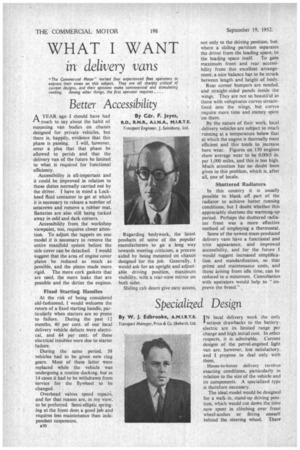WHAT I WANT
Page 64

If you've noticed an error in this article please click here to report it so we can fix it.
in delivery vans
Better Accessibility
By Cdr. P. Jeyes, R.D., R.N.R., A.I.N.A., M.I.R.T.E. AYEAR ago I should have had much to say about the habit of mounting van bodies on chassis designed for private vehicles, but there is, happily, evidence that this phase is passing. I will, however, enter a plea that that phase be allowed to perish and that the delivery van of the future be limited to what is required for functional efficiency.
Accessibility is all-important and it could be improved in relation to those duties normally carried out by the driver. I have in mind a Lockheed fluid container to get at which it is necessary to release a number of setscrews and remove a rubber mat. Batteries are also still being tucked away in odd and dark corners.
Accessibility from the workshop viewpoint, too, requires closer attention. To adjust the tappets on one model it is necessary to remove the entire manifold system before the side cover can be detached. I would suggest that the area of engine cover plates be reduced as much as possible, and the plates made more rigid. The more cork gaskets that are used, the more leaks that are possible and the dirtier the engines.
Fixed Starting Handles At the risk of being considered old-fashioned, I would welcome the return of a fixed starting handle, particularly when starters are so prone to failure. During the past 12 months, 40 per cent. of our local delivery vehicle defects were electrical, and 64 per cent. of these electrical troubles were due to starter failure.
During the same period, 58 vehicles had to be given new ring gears. Most of these latter were replaced while the vehicle was undergoing a routine docking, but in 14 cases it had to be withdrawn from 'service for the flywheel to be changed.
Overhead valves speed repairs, and for that reason are, in .my view, to be preferred. Semi-elliptic springing at the front does a good job and requires less maintenance than independent suspension.
BIO • Regarding bodywork, the latest products of some of the popular manufacturers to go a long way towards meeting criticism, a process aided by being mounted on chassis designed for the job. Generally, I would ask for an upright and adjustable driving position, maximum visibility, with a rear-view mirror on both sides.
Sliding cab doors give easy access, not only to the driving position. but, where a sliding partition separates the driver from the loading space, to the loading space itself. To gain maximum front and rear accessibility from this excellent arrangement, a nice balance has to be struck between length and height of body.
Rear corner bumpers are needed, and straight-sided panels inside the wings. They are not so beautiful as those with voluptuous curves streamlined into the wings, but curves require more time and money spent on them.
By the nature of their work, local delivery vehicles are subject to much running at a temperature below that at which the engine is thermally most efficient and this tends to increase bore wear. Figures on 150 engines show average wear to be 0.0005 in. per 1,000 miles, and this is too high. Much attention has no doubt been given to this problem, which is, after all, one of locale.
Shuttered Radiators
In this country it is usually possible to blank off part of the radiator to achieve hotter running conditions, but I doubt whether this appreciably shortens the warming-up period. Perhaps the shuttered radiator front was a more effective method of employing a thermostat.
Some of the newest mass-produced delivery vans have a functional and trim appearance, and improved accessibility, and for the future I would suggest increased simplification and standardization, so that prime and maintenance costs, and those arising from idle time, can be reduced to a minimum. Consultation with operators would help to "improve the breed."




































































































































































